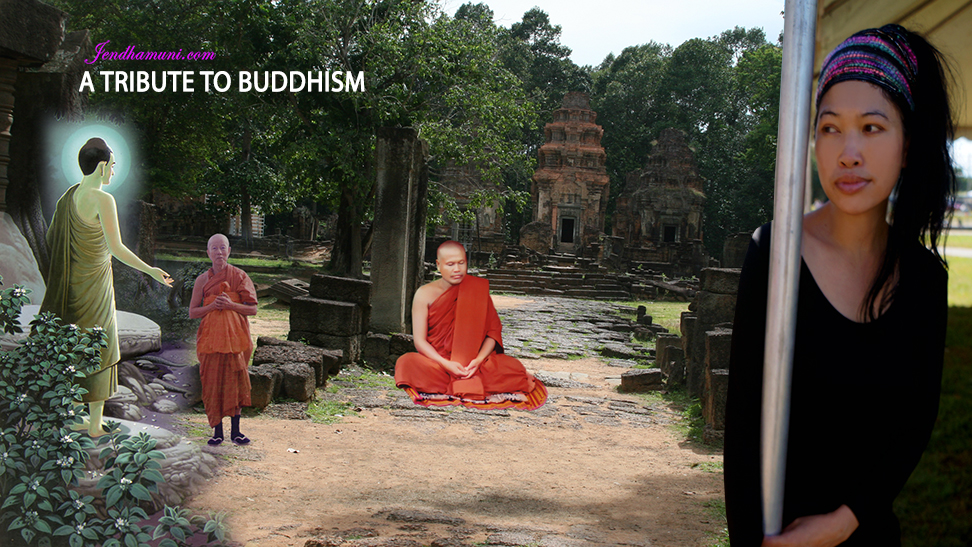The Spiral of Virtue, Concentration and Wisdom
by Ajahn Chah
The Buddha taught a way out of suffering-the causes of suffering and a practical path. In my practice, I just know this simple path-good in the beginning as virtue, good in the middle as concentration, good in the end as wisdom. If you carefully consider these three, you will see that they actually merge into one.
Let us then consider these three related factors. How does one practice virtue? Actually, in developing virtue, one must begin with wisdom. Traditionally, we speak of keeping precepts, establishing virtue, first. Yet for virtue to be complete, there must be wisdom to understand the full implications of virtue. To start, you must examine your body and speech, investigating the process of cause and effect. If you contemplate body and speech to see in what ways they can cause harm, you will begin to understand, control, and purify both cause and effect.
If you know the characteristics of what is skilful and unskilful in physical and verbal behaviour, you already see where to practice in order to give up what is unskilful and do what is good. When you give up wrong and set yourself right, the mind becomes firm, unswerving, concentrated. This concentration limits wavering and doubt as to body and speech. With the mind collected, when forms or sounds come, you can contemplate and see them clearly. By not letting your mind wander, you will see the nature of all experiences according to the truth. When this knowledge is continuous, wisdom arises.
Virtue, concentration, and wisdom, then, can be taken together as one. When they mature, they become synonymous-that is the Noble Path. When greed, hatred, and delusion arise, only this Noble Path is capable of destroying them.
Virtue, concentration, and wisdom can be developed in support of each other, then, like a spiral ever revolving, relying on sights, sounds, smells, tastes, touches, and mind objects. Then whatever arises, Path is always in control. If Path is strong, it destroys the defilements-greed, hatred, and ignorance. If it is’ weak, mental defilements can gain control, killing this mind of ours. Sights, sounds, and so on arise, and not knowing the truth of them, we allow them to destroy us.
Path and defilement walk side by side in this way. The student of Dharma must always contend with both of them, as if there were two persons fighting. When the Path takes control, it strengthens awareness and contemplation. If you are able to remain aware, defilement will admit defeat when it enters the contest again. If your effort is straight on the Path, it keeps destroying defilement. But if you are weak, when Path is weak, defilement takes over, bringing grasping, illusion, and sorrow. Suffering arises when virtues, concentration, and wisdom are weak.
Once suffering has arisen, that which could have extinguished these sorrows has vanished. Only virtue, concentration, and wisdom can cause Path to arise again. When these are developed, the Path starts functioning continuously, destroying the cause for the arising of suffering in each moment and each situation. This struggle continues until one side conquers, and the matter can be brought to an end. Thus, I advise practicing unceasingly.
Practice-begins here and now. Suffering and liberation, the entire Path, are here and now. The teachings, words like virtue and wisdom, only point to the mind. But these two elements, Path and defilement, compete in the mind all the way to the end of the Path. Therefore, applying the tools of practice is burdensome, difficult-you must rely on endurance, patience, and proper effort. Then true understanding will come about on its own.
Virtue, concentration, and wisdom together constitute the Path. But this Path is not yet the true teaching, not what the teacher actually wanted, but merely the Path that will take one there. For example, say you traveled the road from Bangkok to WatBa Pong; the road was necessary for your journey, but you were seeking the monastery, not the road. In the same way, we can say that virtue, concentration, and wisdom are outside the truth of the Buddha but are the road that leads to this truth. When you have developed these three factors, the result is the most wonderful peace. In this peace, sights or sounds have no power to disturb the mind. There is nothing at all left to be done. Therefore, the Buddha says to give up whatever you are holding on to, without anxiety. Then you can know this peace for yourself and will no longer need to believe anyone else. Ultimately, you will come to experience the Dharma of the Noble Ones.
However, do not try to measure your development quickly. Just practice. Otherwise, whenever the mind becomes calm, you will ask, “Is this it?” As soon as you think like this, the whole effort is lost. There are no signs to attest to your progress, like the one that says, “This is the path to WatBa Pong.” Just throw away all desires and expectations and look directly at the ways of the mind.

















